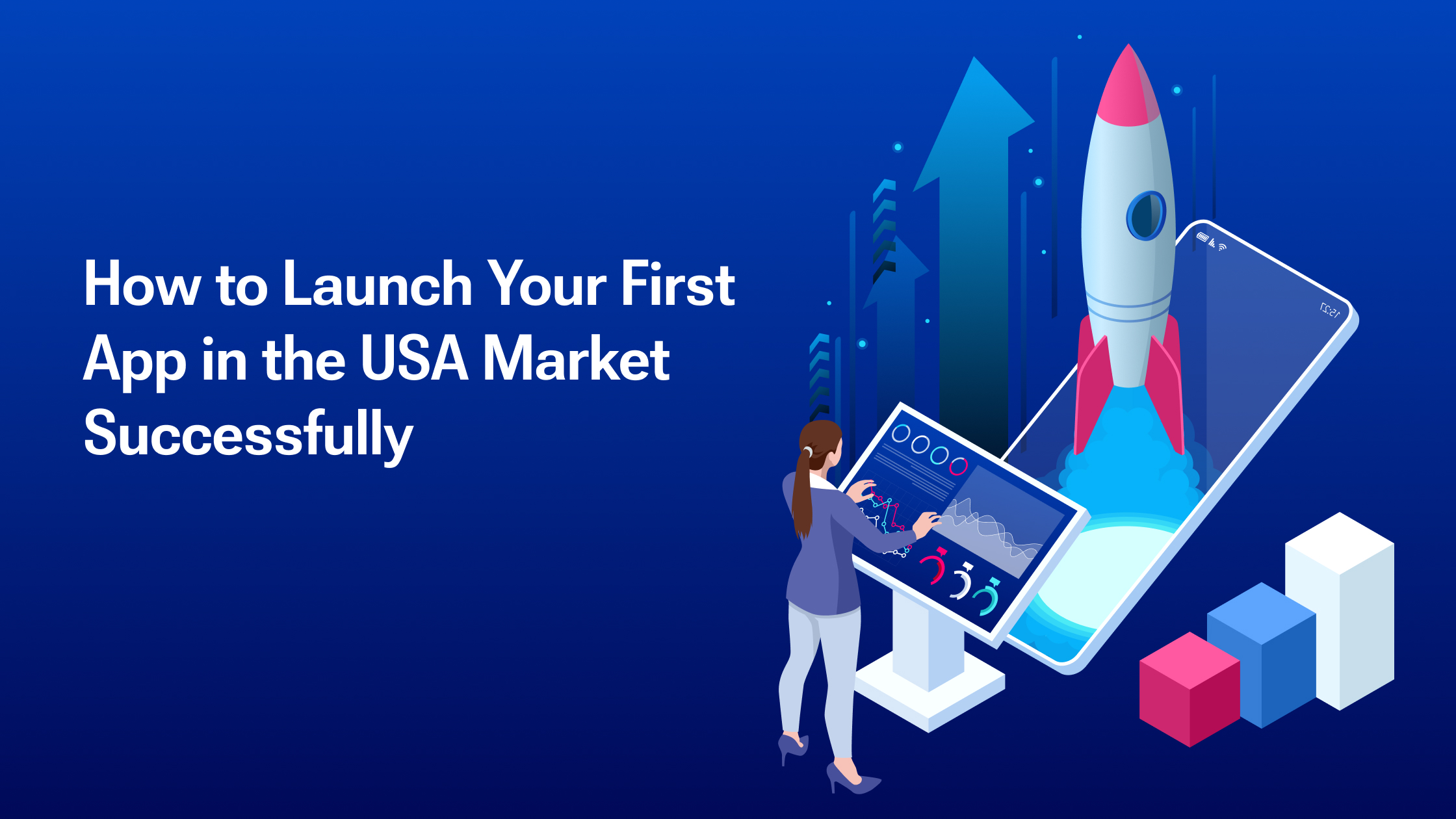Launching a new mobile app in the United States—one of the world’s largest and most competitive app markets—can be both thrilling and overwhelming. With over 100,000 apps released each month on Google Play and the Apple App Store combined, standing out and making a successful debut requires a mix of preparation, marketing, and strategic execution.
Whether your app is for Android, iOS, or both, partnering with a reliable mobile app development company in USA can make a significant difference in navigating the complexities of the launch process.

This guide outlines a comprehensive roadmap of app launch marketing strategies in the U.S. market, including submission steps, challenges, timelines, and post-launch strategy.
Why Should You Launch a Mobile App in the USA Market?
Before diving into the how-to, it’s important to understand why targeting the USA is a smart move:
- High User Spending: The app localization for US users leads to consumer app spending, especially on iOS.
- Early Adopters: Users are more open to trying new apps, making it ideal for testing MVPs.
- Business Ecosystem: Strong media, investor, and partnership opportunities.
Step-by-Step: Preparing to Launch Your App
Here is a simple mobile app launch checklist to submit your app in the USA market without any hassle:
1. Market Research & Competitive Analysis
Before launching your app in the USA, performing in-depth market research and analyzing competitors’ research is crucial. Start by identifying your niche and key competitors to understand where your app fits.
Additionally, analyzing user reviews of similar apps can help you uncover common pain points or feature gaps that your app can address, giving you a competitive edge.
2. Build an MVP or Feature-Ready App
Begin your launch journey by building a minimum viable product (MVP) or a feature-ready version of your app. Focus on delivering a lean but functional core experience that showcases the app’s main value proposition.
Ensure your app adheres to platform-specific design guidelines—Material Design for Android and Human Interface Guidelines for iOS—to create a native and seamless user experience. Prioritizing UI consistency and usability will help attract and retain early users.
3. Compliance with U.S. Regulations
Compliance is non-negotiable when entering the U.S. market. Here are following regulations you must follow when build an app:
- The Children’s Online Privacy Protection Act (COPPA)
- The California Consumer Privacy Act (CCPA)
- The General Data Protection Regulation (GDPR)
Ensure your app includes a clear privacy policy, user data protection mechanisms, and consent flows to remain legally compliant and gain user trust.
4. Beta Testing & Feedback
Beta testing for mobile apps will be carried out prior to the official launch to uncover potential bugs and collect valuable user feedback. To distribute your app to testers, use platforms like TestFlight for iOS or the Google Play Console’s Internal Testing feature for Android.
Involve U.S.-based users in your testing phase to ensure your app meets cultural expectations and functions effectively in the local market. Early feedback from real users allows you to fine-tune features, fix usability issues, and increase the chances of a successful launch.
How to Submit Your App: Android & iOS
For Android: Submitting to Google Play Store
Step-by-Step:
- Create a Developer Account: $25 one-time fee on Google Play Console.
- Prepare Your APK/AAB File: Build and sign your release version.
- Create App Listing: Add app name, description, screenshots, category, and content rating.
- Privacy & Policy: Add a privacy policy URL and fill in Data Safety.
- Testing & Release: Choose internal, closed, or open testing before public launch.
- Publish: Once reviewed (usually within 2–7 days), your app goes live.
Tips:
- Use rich visuals and preview videos.
- Include localized U.S. English content.
- Optimize metadata with relevant keywords.
For iOS: Submitting to the Apple App Store
Step-by-Step:
- Enroll in the Apple Developer Program: $99/year.
- Build & Archive in Xcode: Submit the app via Xcode.
- Add Screenshots: Use iPhone 13/14 mockups for U.S. appeal.
- Fill out the app privacy details: Specify data usage and user tracking.
- Submit for Review: Apple manually reviews all apps (takes 24–72 hours or more).
- Launch & Monitor: Release it publicly or via phased rollout after approval.
Tips:
- Adhere strictly to Apple’s guidelines.
- Avoid mentioning competitors or making exaggerated claims.
App Launch Timeline: From Development to Launch (Estimated)
Phase Timeframe
Market Research & Planning 2–3 weeks
Design & Development 2–4 months
Beta Testing & Feedback 2–3 weeks
App Store Submission 1–2 weeks
Marketing & Pre-Launch Ongoing from month 2
Total Time to Launch ~3–6 months
Common Challenges You Might Face When Launch Your App in USA Market
Here are a few challenges you need to be aware of when planning to publish your first app in the USA market, along with solutions:
- App rejection from Apple or Google: Incomplete metadata, bugs or crashes, and privacy violations can lead to rejection.
Solution: Follow platform guidelines thoroughly and conduct extensive QA testing before submission.
- Cultural misalignment: U.S. users expect intuitive UX, region-specific design elements, and culturally relevant messaging.
Solution: Use American English, U.S.-based beta testers, and align your monetization strategy with U.S. user behavior.
- Discoverability & competition: With millions of apps on the market, getting noticed is a major challenge.
Solution: Focus on App Store Optimization (ASO), collaborate with influencers, and invest in early PR efforts.
- Monetization strategy: Choosing between freemium, ads, or subscriptions can be tricky without user insights.
Solution: Start with a free version and introduce upsell features based on user engagement data.
Strategies for a Successful Launch
Launching an app successfully involves a well-rounded strategy that begins long before the actual release. Start with strong pre-launch marketing strategies by building hype through a compelling landing page, teaser videos, and an email collection campaign. Engage early with potential users by actively participating in Reddit, Twitter, LinkedIn, and Product Hunt communities. Consider running a beta user campaign by offering early access in exchange for valuable feedback—this helps refine the product and builds a loyal user base.
Next, focus on App Store Optimization (ASO). Use keyword-rich titles and descriptions to improve visibility in app stores. Ensure that your app listing includes high-quality screenshots and an engaging video preview that showcases your app’s core features. Regular updates and strong user ratings contribute significantly to higher rankings in both the App Store and Google Play.
Influencer and paid mobile app marketing strategies also play a crucial role. Partnering with micro-influencers within your niche can authentically expose your app to a targeted audience. Complement this with paid campaigns such as Apple Search Ads and Google App Campaigns to precisely reach U.S.-based users, especially during the launch window.
Localization is another key factor for success in the U.S. market. Make sure your app uses American spelling, idioms, and design preferences. Highlight features that align with U.S. user expectations, such as Apple Pay integration, dark mode, and strong privacy controls.
Once the app is live, your focus should shift to post-launch app support, growth, and stability. Monitoring analytics is critical—use tools like Firebase (for Android), App Store Analytics (for iOS), Mixpanel, or Amplitude to understand user journeys, and Crashlytics for real-time issue tracking. Pay close attention to user reviews. Prompt users for feedback within the app and respond to negative reviews promptly to improve ratings and show responsiveness.
Continuous improvement is essential. Aim to release updates every 2–4 weeks, including bug fixes, minor enhancements, and UI/UX tweaks based on user feedback. Also, pitch your app to media outlets and tech blogs using platforms like Product Hunt, BetaList, or even paid press release services to drive credibility and traffic.
Monetization and Scale
- Test subscription tiers or ad formats.
- Add in-app purchases based on behavioral data.
- Expand to international markets once you’ve stabilized U.S. traction.
Bonus Tips: Scaling for Success
- Add Referral Programs: Incentivize early users to share.
- A/B Test Onboarding: Optimize your first-time user experience.
- Incorporate Push Notifications: Increase engagement, but don’t spam.
- Use Retargeting Ads: Bring back inactive users with Facebook Ads or Google UAC.
Final Thoughts
Launching your first app in the USA is not just about uploading it to the app store—it’s about creating a well-researched, user-friendly, and strategically promoted product. From development to post-launch optimization, each step plays a crucial role in whether your app will sink or soar in a highly competitive market.
With the right preparation, understanding of both Android and iOS platforms, and a focus on continuous improvement, your app can survive its first launch in the U.S. and thrive.






